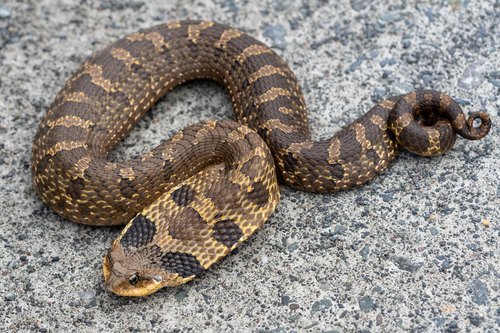
Eastern Hog-nosed Snake
The Eastern Hognose Snake, with its iconic upturned snout, dazzles with dramatic defensive displays, including playing dead. Found in North America's sandy and wooded terrains, it thrives on a diet of amphibians. Its peculiar antics and ecological role make it a captivating species to observe.
12-18 years
Lifespan
Length: 61 - 84 cm
Size
Brown, Grey, Yellow, Red, Black, Tan, Green, Dark, Cream
Color
2-3 years
Age of Sexual Maturity
Low
Aggression
Least Concern
Conservation Status
Stable
Population Trend
Characteristics
Heterodon platirhinos, commonly known as the Eastern Hognose Snake, is a non-venomous snake native to North America. It is recognized for its distinctive upturned snout, used for digging in sandy soils. This snake exhibits unique defensive behaviors, such as playing dead and flattening its neck like a cobra. It primarily inhabits woodlands, fields, and sandy areas, feeding on amphibians, especially toads.
Distribution Range of the Eastern Hog-nosed Snake
Heterodon platirhinos, commonly known as the Eastern Hog-nosed Snake, is native to North America. Its geographical distribution includes the eastern United States, ranging from southern New Hampshire and southern Ontario, Canada, south to Florida, and west to eastern Texas, Nebraska, and Kansas.
Eastern Hog-nosed Snake's Habitat
Environmental Conditions
The Eastern Hog-nosed Snake typically inhabits areas with loose, sandy soils which are ideal for its burrowing behavior. It is commonly found in regions such as woodlands, fields, farmlands, and coastal areas. The climate in its range varies widely, from humid subtropical in the southeast to more temperate conditions in the northern parts of its range.
Ecological Niche
Heterodon platirhinos is well adapted to environments that support its primary diet of amphibians, especially toads. Its ecological niche includes occupying roles as both predator and prey within its ecosystem. The species has developed unique behavioral adaptations such as playing dead as a defense mechanism against predators.
Copyright @ Nature Style Limited. All Rights Reserved.
 English
English